1.12.2023
China releases 1st images of complete Tiangong space station (photos)
The pictures represent the first time the full structure of the Tiangong space station has been fully imaged since it arrived in orbit.

China's Tiangong space station as seen by the crew of Shenzhou 16 upon leaving the station. (Image credit: CMSE)
The crew of China's Shenzhou 16 mission captured incredible images of the Tiangong Space Station as they departed on their way back to Earth.
The pictures, taken with a high-definition camera, represent the first time the full structure of the Tiangong space station has been fully imaged since it arrived in orbit.
Prior to disembarking, the Shenzhou 16 team handed control of the space station over to the Shenzhou 17 crew, who arrived at Tiangong on Oct. 26. The three taikonauts (Chinese astronauts) consisting of commander Jing Haipeng, Zhu Yangzhu and Gui Haichao then left Tiangong on Oct. 30 in the Shenzhou 16 return capsule and arrived back from low-Earth orbit on the same day.
As they made their way toward Earth, the crew turned their cameras toward their former temporary home, capturing breathtaking views of the laboratory in orbit above Earth.
Located at 217 and 280 miles (340 to 450 kilometers) over the planet, the first unit of the Tiangong known as Tianhe arrived in low-Earth orbit in 2021. Its first crew, Shenzhou 12, arrived at the space station on June 16, 2021. They spent 90 days at the station, which was three times longer than any prior taikonaut mission.
The second and third units of the space station, Wentian and Mengtian, were launched in 2022 and 2023, respectively. This completed the 180-foot (55-meter) long station, which weighs 77 tons and is about 20% as large as the International Space Station.
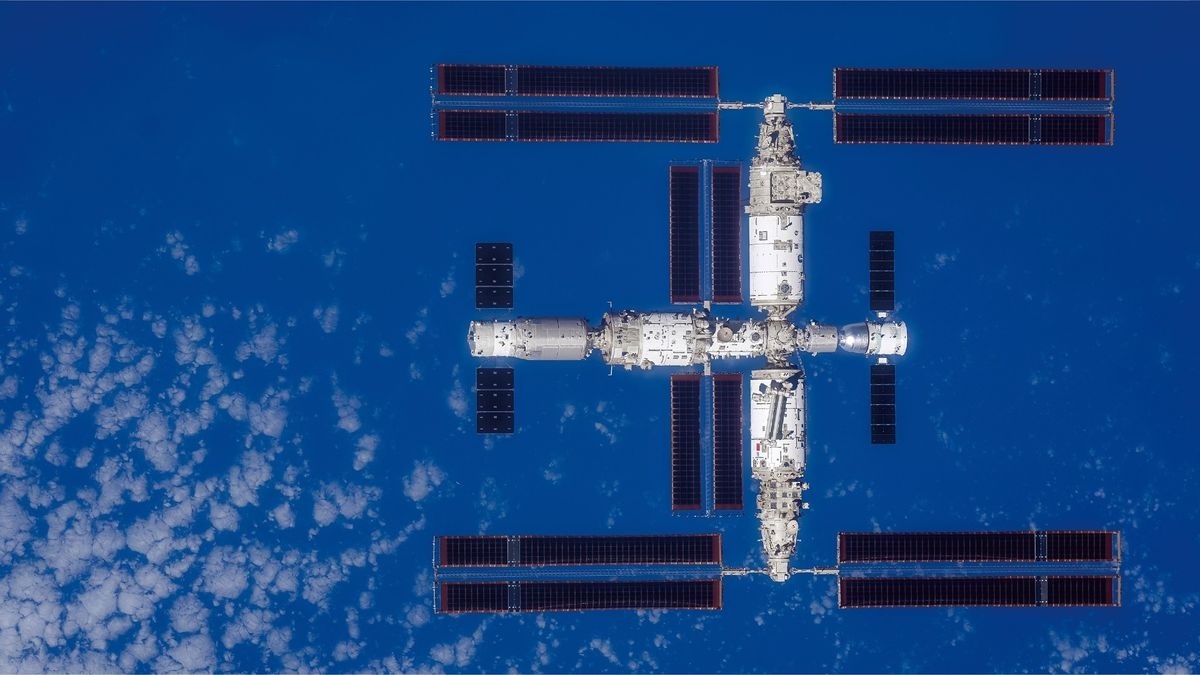
China's Tiangong space station as seen by the crew of Shenzhou 16 upon leaving the station. (Image credit: CMSE)
Since then, Tiangong — whose name means "Heavenly Palace" — has hosted a rotating crew of three taikonauts who have performed a host of important science experiments, something the CMSA aims to maintain for at least a decade.
The crew of Tiangong 16, the fifth team to inhabit the space station, continued the scientific exploration conducted aboard the space station by conducting a spacewalk, growing vegetables, and conducting a live lecture from space during which they demonstrated lighting a match in microgravity.
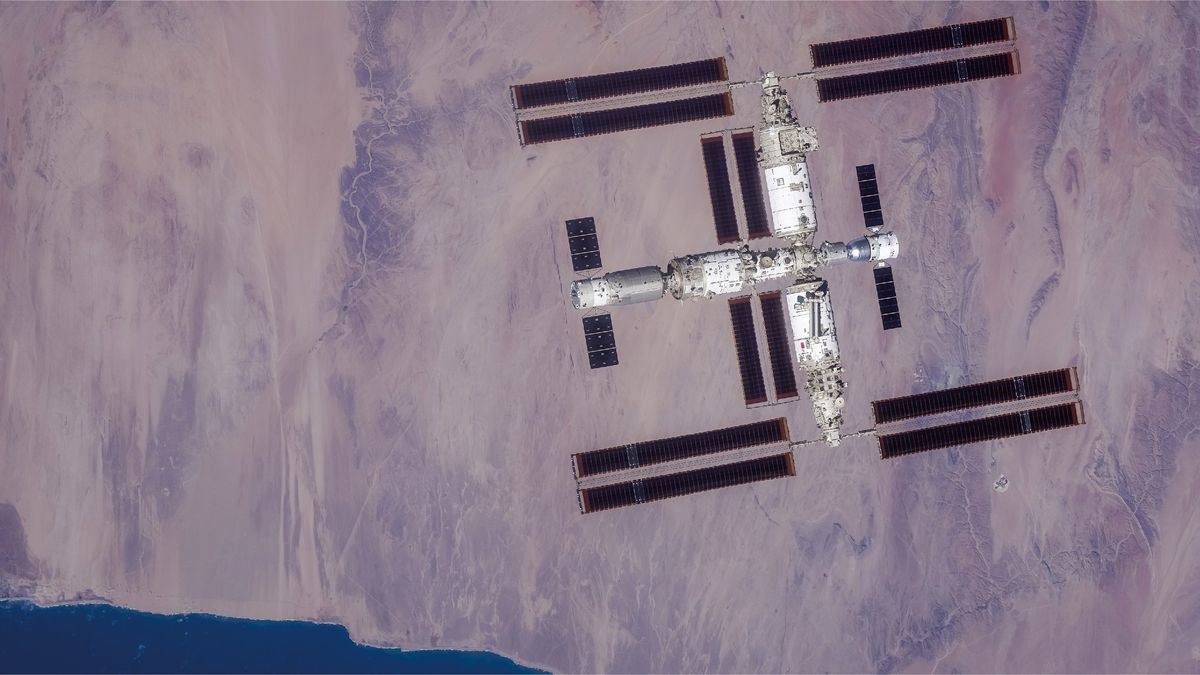
China's Tiangong space station as seen by the crew of Shenzhou 16 upon leaving the station. (Image credit: CMSE)
The stunning Shenzhou 16 images may capture Tiangong in its full glory as it is currently, but if the CMSA gets its way, the image will soon be out of date. On Oct. 4 at the 47th International Astronautical Congress in Baku, the space agency revealed it intends to expand the space station with an extra three modules, bringing its total unit count up to six.
In addition to this, the CMSA intends to send Tiangong some company in the form of a Hubble-class space telescope called "Xuntian" that will orbit Earth alongside the space station and will be capable of meeting up with it for repairs, refueling, and even upgrading.
Quelle: SC
----
Update: 21.12.2023
.
Shenzhou-17 crew to do extravehicular activities
The Shenzhou-17 crew members, who are currently on board China's space station, will conduct their first extravehicular activities (EVAs) within the next few days, the China Manned Space Agency (CMSA) announced on Wednesday.
The astronauts have been stationed in the orbital complex for 54 days, nearly one-third of their six-month space mission.
They have completed the crew rotation with Shenzhou-16 astronauts, space station platform maintenance, life and health support, extravehicular spacesuit inspection and testing, Tianzhou-6 cargo ship equipment inspection, and preparation for the upcoming spacewalk, according to the CMSA.
They also practiced robotic arm operation training, emergency life-saving drills, medical rescue drills, and full-system pressure emergencies. Experiments in space science are advancing steadily.
The CMSA said the Shenzhou-17 crew is in good health, and the space station combination is running stably.
Quelle: Xinhua
----
Update: 23.12.2023
.
Shenzhou-17 astronauts conduct first spacewalk to repair solar array
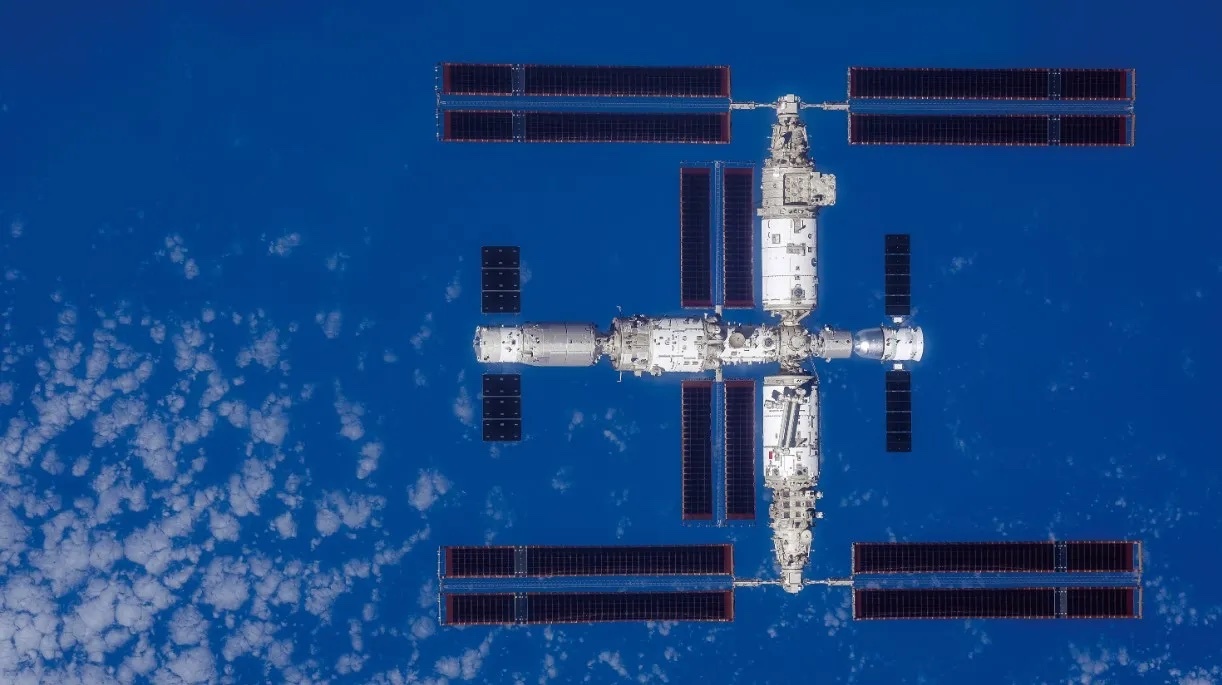
HELSINKI — China’s Shenzhou-17 astronauts embarked on their first extravehicular activity Thursday to address minor damage to a Tiangong space station solar array.
Mission commander Tang Hongbo and Tang Shengjie began a roughly 7.5-hour extravehicular activity (EVA), or spacewalk, Thursday. The pair reentered Tiangong through the Wentian science module’s EVA hatch at 8:35 a.m. Eastern (1335 UTC) Dec. 21, according to the China Manned Space Engineering Office (CMSEO).
Shenzhou-17 spacewalk tasks included a repair test on one of the Tianhe core module’s solar arrays. The system was earlier found to have suffered minor damage through micrometeoroid hits.
The successful experimental repair work could be seen as a big step for China as it aims to keep its Tiangong space station operational and permanently occupied for at least a decade.
Crewmate Jiang Xinlin assisted operations from inside Tiangong through the use of the space station’s robotic arm. Tang Shengjie, 34, became China’s youngest astronaut to embark on an EVA so far.
Tang Hongbo completed his first spacewalk back in July 2021 during the Shenzhou-12 mission — the first to visit the Tianhe core module.
“This extravehicular activity is extraordinarily significant, and extremely challenging. It is an in-orbit maintenance in its true sense,” Tang Hongbo said after the spacewalk, according to CCTV.
“At that moment, being there, I deeply felt the vastness of the starry sky and the profound meaning of infinite space exploration,” Tang Hongbo said.
A highlight video released by CMSEO showed the astronauts conducting closeup examinations of the solar array, assisted by the station’s robotic arms.
The EVA posed new challenges for the astronauts, according to Dong Nengli, deputy chief designer of China’s human spaceflight program.
“For the previous extravehicular activities, the major tasks for astronauts were to install and check. This round of extravehicular activities on Thursday we call experimental servicing,” Dong told CCTV.
“This time the astronauts operated on one of the solar wings. It is flexible, to a certain extent, and also very thin, which limits the space of operation to a certain degree,” Dong said.
Dong added that the successful EVA meant the teams had mastered the ability for some extravehicular repairs. Success was thus, “laying a solid foundation for us to guarantee the space station’s safety and reliability in the future.”
The work required close coordination with the ground. “The repair work requires a very high level of precision, so it demands high precision in astronauts’ operation and proficiency in their use of tools,” Wang Yanlei, director of the astronaut selection and training department of the China Astronaut Research and Training Center, told CCTV.
“They also had to confirm the coordination between ground and space, and verify the accuracy of the position.” Wang added.
Evolving Tiangong plans
China completed construction of Tiangong in October 2022 and is further developing its plans for its utilization.
CMSEO is planning to launch an additional module which will allow the expansion of the orbital outpost. Yang Liwei, the country’s first astronaut to fly to space, says a process to select the first international astronauts to visit Tiangong is underway.
A report from the Air Force’s China Aerospace Studies Institute (CASI) earlier this year noted that how CMSEO operates Tiangong, such its opening participation to civilian astronauts and nonstate-owned enterprise (SOE) companies, could probably change the global image of the Chinese space program. CMSEO operates under China’s People’s Liberation Army (PLA).
Gui Haichao became the first Chinese civilian in space during the five-month-long Shenzhou-16 mission earlier this year.
Commercial launch firms may also get to play a role in a new low-cost cargo system to supply Tiangong. Tomas Hrozensky, a senior research fellow at the European Space Policy Institute (ESPI), told SpaceNews earlier this year that the CMSEO cargo program is a clear indication that China is seeking to replicate the approach which yielded NASA a major success.
Also Dec. 21 components for a Long March 7 rocket arrived at the coastal Wenchang spaceport. The rocket will launch the Tianzhou-7 cargo mission to Tiangong in mid January.
China's Tianzhou-6 cargo craft separates from space station combination
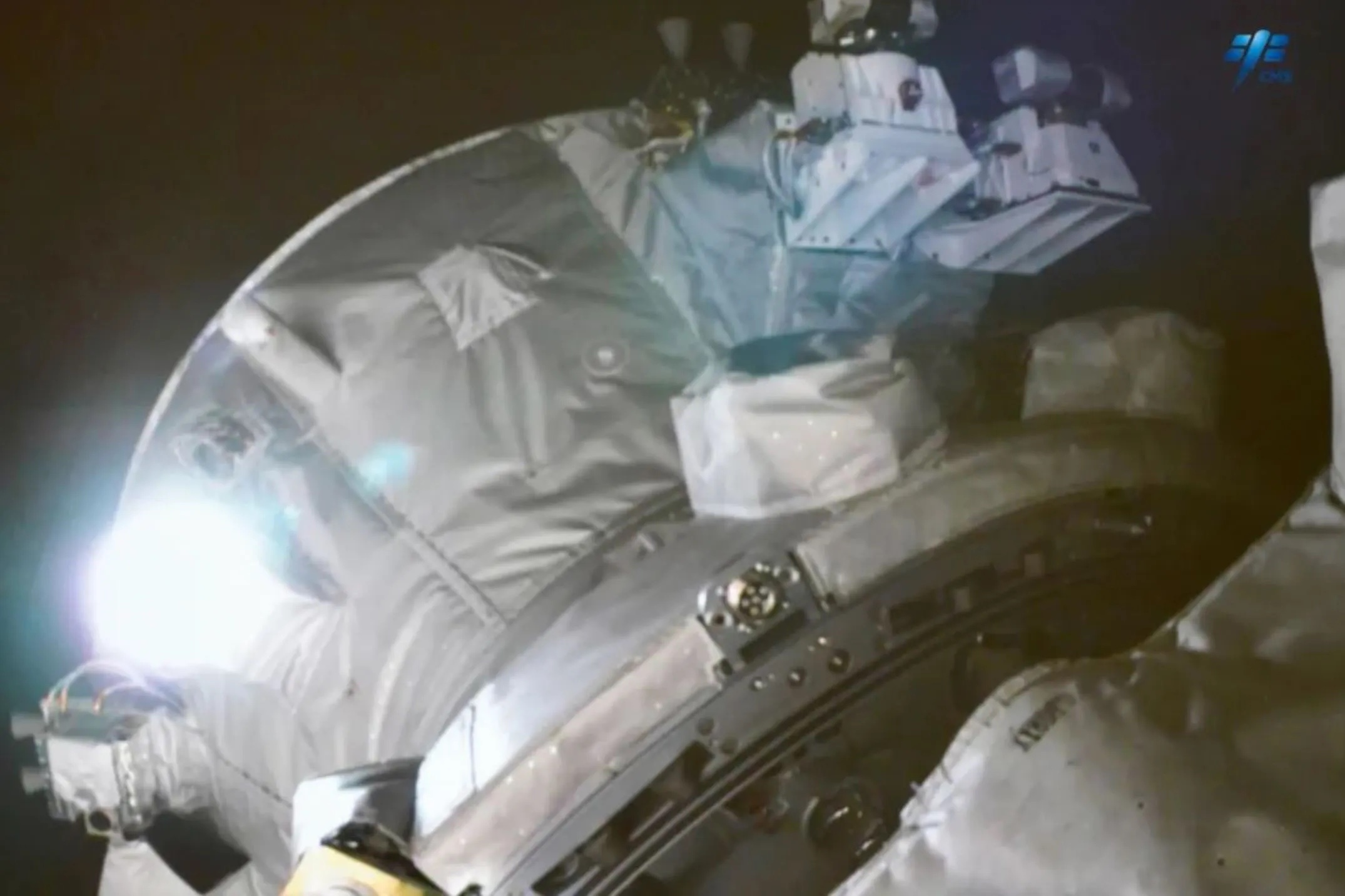
The Tianzhou-6 cargo craft, tasked with carrying supplies for China's space station, separated from the station combination at 4:02 p.m. Friday (Beijing Time) and switched to independent flight, according to the China Manned Space Agency (CMSA).
The cargo craft will re-enter the atmosphere in a controlled manner in the future. Most of its components will burn up and be destroyed during the process, while a small amount of debris will fall into designated safe waters in the South Pacific, the CMSA said.
Launched on May 10, 2023, Tianzhou-6 has a loading capacity reaching over 7 tonnes, making itself the world's largest cargo spacecraft in service.
According to the CMSA, last month, Tianzhou-7, the spacecraft for the country's next space cargo mission, was transported to the launch site in the southern province of Hainan. Along with its carrier rocket, the cargo craft underwent assembly and testing to gear up for the launch as planned.
Quelle: Xinhua
----
Update: 21.01.2024
.
Shenzhou-16 taikonauts meet press after return from space
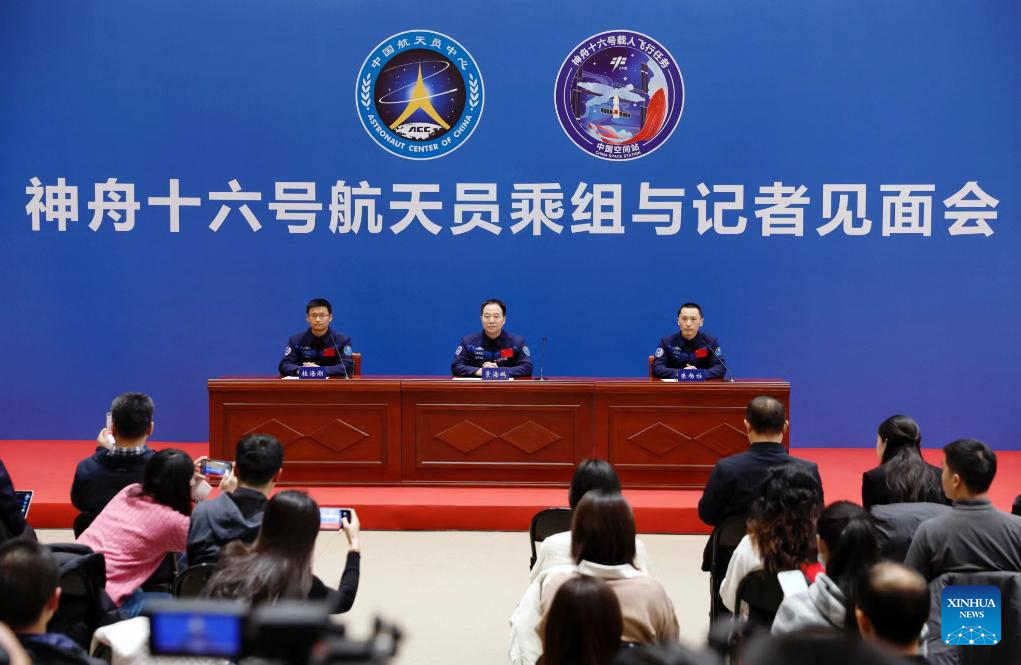
Taikonauts from China's Shenzhou-16 crewed mission meet the press in Beijing, capital of China, Jan. 19, 2024. The three taikonauts from China's Shenzhou-16 crewed mission made their first public appearance in Beijing on Friday, 80 days subsequent to their return from space.
The Shenzhou-16 spaceship was launched from the Jiuquan Satellite Launch Center on May 30, 2023, carrying three crew members: Jing Haipeng, Zhu Yangzhu, and Gui Haichao. (Photo by Han Haidan/Xinhua)
The three taikonauts from China's Shenzhou-16 crewed mission made their first public appearance in Beijing on Friday, 80 days subsequent to their return from space.
The Shenzhou-16 spaceship was launched from the Jiuquan Satellite Launch Center on May 30, 2023, carrying three crew members: Jing Haipeng, Zhu Yangzhu, and Gui Haichao. They stayed in orbit for 154 days, during which they conducted one extravehicular activity and delivered the fourth live class from the Tiangong space station.
Wearing four badges of honor from his successful spaceflights on his chest, commander Jing said his crew, for the first time, comprised a diverse trio of taikonauts from different career backgrounds, including aircraft pilot, flight engineer, and payload specialist.
"Professional handles professional affairs," said the senior pilot, adding that the division of work was clear-cut, each one being charged with specific tasks.
The Shenzhou-16 mission marked Jing's fourth journey into space, making him the most experienced taikonaut.
Flight engineer Zhu was responsible for the maintenance and repair of the space station platform. He said the greatest challenge was to ensure "zero mistakes in daily operations" during the five-month mission.
"We successfully completed the mission and ensured the safe, stable, efficient, and long-term operation of the space station," Zhu told the media.
Payload specialist Gui was the first civilian taikonaut to fly in space. "Having the opportunity to participate in a multitude of cutting-edge research projects in space was an extraordinary experience, and I take great pride in it," Gui shared his feelings.
The spectacled university professor said he would incorporate the accomplishments attained throughout the space mission into his future scientific research endeavors, classroom instruction, and talent cultivation.
The three crew members were in good health. After the medical quarantine and recuperative care, they will undergo a health assessment before returning to normal training.
Quelle: Xinhua
+++
Tianzhou-6 cargo craft re-enters atmosphere after completing mission
China's Tianzhou-6 cargo craft re-entered the atmosphere in a controlled manner at 8:37 p.m. (Beijing Time) Friday, according to the China Manned Space Agency.
Most of the spacecraft's components burned up during the re-entry, and a small amount of its debris fell into the scheduled safe waters.
The Tianzhou-6 separated from the orbiting Tiangong space station combination on Jan. 12 and successfully released an experiment satellite developed by the Dalian University of Technology during its independent flight.
Launched on May 10, 2023 from the Wenchang Spacecraft Launch Site in the southern island province of Hainan, the Tianzhou-6 was loaded with propellants, materials for scientific experiments and supplies for taikonauts.
Quelle: Xinhua
----
Update: 25.01.2024
.
Chinese astronauts check out newly delivered space station supplies
Astronauts entered the Tianzhou 7 freighter after its arrival at Tiangong.
Astronauts aboard China's space station have entered a newly arrived cargo spacecraft to begin sorting and checking out the goods.
The freighter, called Tianzhou 7, launched on a Long March 7 rocket from Wenchang Satellite Launch Center on Jan. 17, arriving at the Tiangong space station just over three hours later.
Footage released on Tuesday (Jan. 23) by the China Manned Space Engineering Office shows the Shenzhou 17 astronauts opening the hatch to Tianzhou 7 and beginning the work of sorting through its cargo.

The astronauts of China's Shenzhou 17 mission unload cargo from the Tianzhou 7 freighter aboard the Tiangong space station in January 2024. (Image credit: CCTV)
There are around 250 cargo packages inside Tianzhou 7's pressurized cabin with a total mass of about 12,350 pounds (5,600 kilograms). This material includes daily supplies for astronauts, maintenance kits and spare parts for space station equipment, samples for experiments and station propellant.
The supplies will feed Shenzhou 17 mission commander Tang Hongbo, 48, and his former fighter pilot crewmates, Tang Shengjie and Jiang Xinlin, for the remainder of their six-month-long mission in orbit. They will also provide for part of the future Shenzhou 18 mission.
Tianzhou 7 also bears Chinese New Year gift packages for the Shenzhou 17 astronauts, and gifts for the handover to the next crew to arrive at Tiangong.
Tiangong, which is about 20% as massive as the International Space Station, is a T-shaped structure consisting of three modules. Tianzhou 7 is the sixth cargo mission to arrive at the orbital outpost since its construction began in 2021.
Quelle: SC
----
Update: 31.01.2024
.
Shenzhou 18 and 19 crews undertake intensive training for next missions
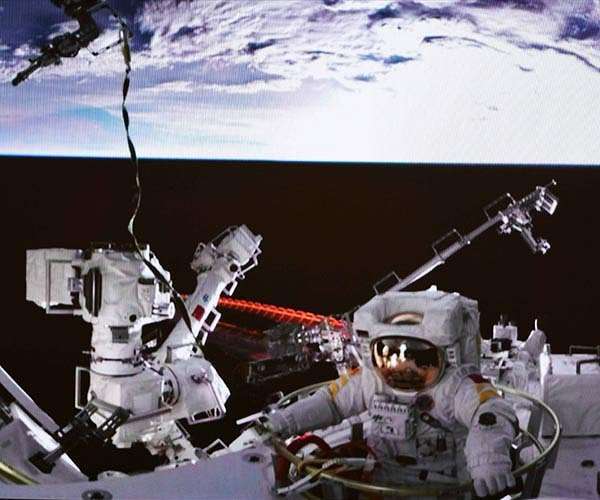
Crew members selected for China's upcoming manned space missions, Shenzhou XVIII and Shenzhou XIV, are currently engaged in rigorous training programs, as revealed by Yang Liwei, a prominent figure in the nation's space endeavors. Liwei, who earned distinction as China's first astronaut and now plays a pivotal role in the planning of the manned space program, recently shared these insights on China Central Television (CCTV).
The training regimen for these astronauts goes beyond basic spaceflight preparation. According to Yang, it encompasses specialized tasks to be performed aboard the Tiangong space station. These tasks include scientific experiments, equipment installation, and maintenance, highlighting the significant responsibilities astronauts undertake during their orbital missions.
In addition to these technical skills, the crew members are also being prepared to handle unforeseen scenarios and emergencies. This comprehensive training approach underscores the complexity and challenges of space missions, ensuring that astronauts are well-equipped to manage a variety of situations in the unique environment of space.
Yang, speaking to the state broadcaster, detailed the upcoming schedule for China's space endeavors. The Shenzhou XVIII and XIV missions, along with the Tianzhou 8 robotic cargo ship, are slated for launch within the year. This ambitious schedule reflects China's commitment to advancing its capabilities in space exploration and research.
The Tiangong space station, orbiting approximately 400 kilometers above Earth, is a testament to China's growing prowess in space. Comprising a core module and two science capsules, this modular station plays host to various scientific endeavors and serves as a hub for crew and cargo spacecraft. At present, Tiangong is manned by three astronauts from the Shenzhou XVII mission, who have been on board since October 26. Their tenure, marking the sixth crew to inhabit the station, is scheduled to culminate in April after approximately six months in space.
The upcoming missions of Shenzhou XVIII and XIV are poised to continue China's exploration and utilization of space, further solidifying the nation's position in the international space community. As these astronauts undergo their preparatory phase, they not only ready themselves for the tasks ahead but also carry the aspirations of a nation keen on expanding its horizons beyond Earth.
Quelle: SD
----
Update: 3.03.2024
.
Shenzhou-17 crew completes in-orbit repairs during 2nd extravehicular mission

This screen image captured at Beijing Aerospace Control Center on March 2, 2024 shows Shenzhou-17 astronaut Tang Hongbo performing extravehicular activities. The Shenzhou-17 crew members, who are currently on board China's space station, have completed their second extravehicular mission on Saturday. (Xinhua/Li He)
The Shenzhou-17 crew aboard China's orbiting space station carried out their second extravehicular mission on Saturday, the China Manned Space Agency has said.
Taikonauts Tang Hongbo, Tang Shengjie and Jiang Xinlin successfully completed all assigned tasks at 1:32 p.m. (Beijing time), after approximately eight hours of extravehicular activities. They worked together closely with the support of the space station's robotic arm and scientific researchers on Earth.
A spacewalk was conducted by Tang Hongbo and Jiang Xinlin, who have since returned safely to the Wentian lab module.
China launched the Shenzhou-17 manned spaceship on Oct. 26, 2023. Its crew conducted a repair test in their first extravehicular mission on Dec. 21 last year.
During their second extravehicular mission, the three taikonauts completed maintenance work on the Tianhe core module's solar wings, addressing the impact of small space particles. According to the agency, the solar wing's power generation function is operating normally after evaluation and analysis.
It was the first time the taikonauts completed the in-orbit maintenance of extravehicular facilities. The Shenzhou-17 crew also inspected the status of the space station's modules during their spacewalk.
The three taikonauts are scheduled to carry out a variety of space science and technology experiments during the remainder of their space journey, the agency said.
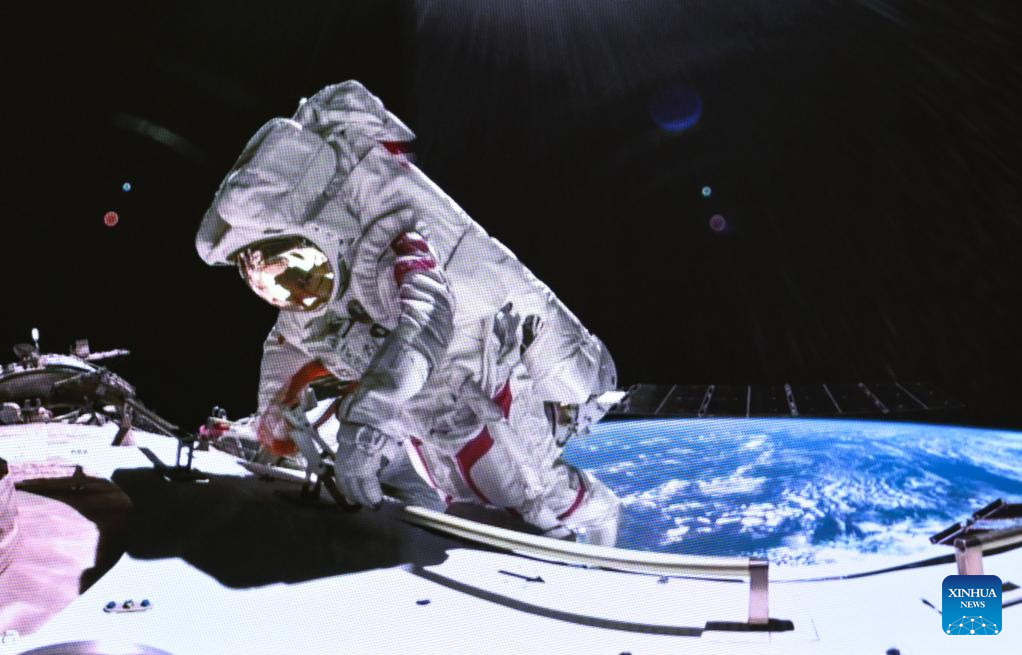
This screen image captured at Beijing Aerospace Control Center on March 2, 2024 shows Shenzhou-17 astronaut Tang Hongbo performing extravehicular activities. The Shenzhou-17 crew members, who are currently on board China's space station, have completed their second extravehicular mission on Saturday. (Xinhua/Li He)
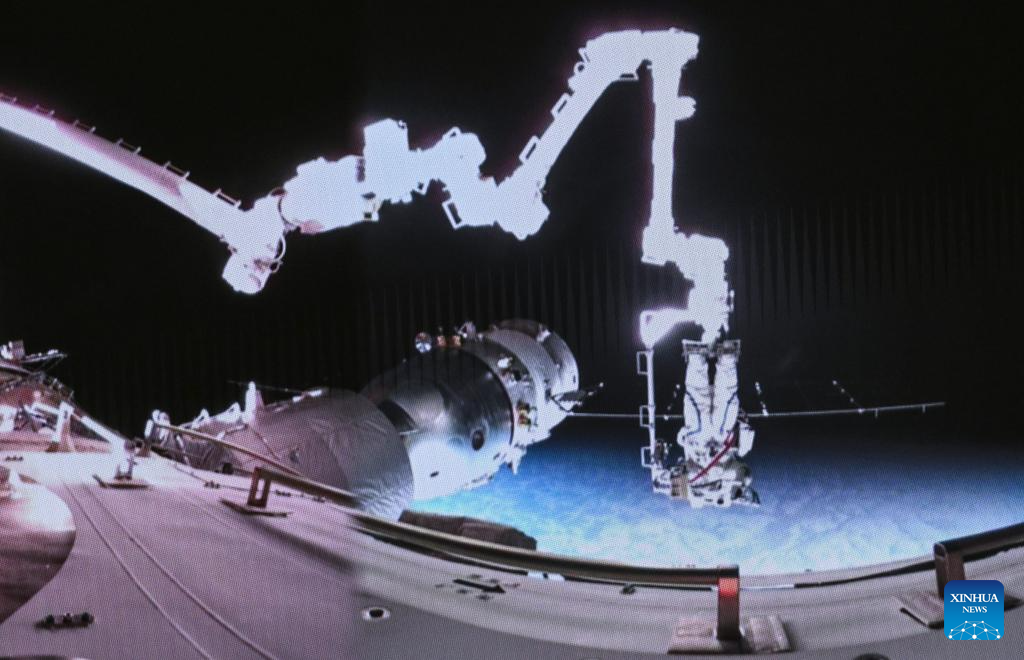
This screen image captured at Beijing Aerospace Control Center on March 2, 2024 shows Shenzhou-17 astronaut Jiang Xinlin performing extravehicular activities assisted by the robotic arm of the space station. The Shenzhou-17 crew members, who are currently on board China's space station, have completed their second extravehicular mission on Saturday. (Xinhua/Li He)
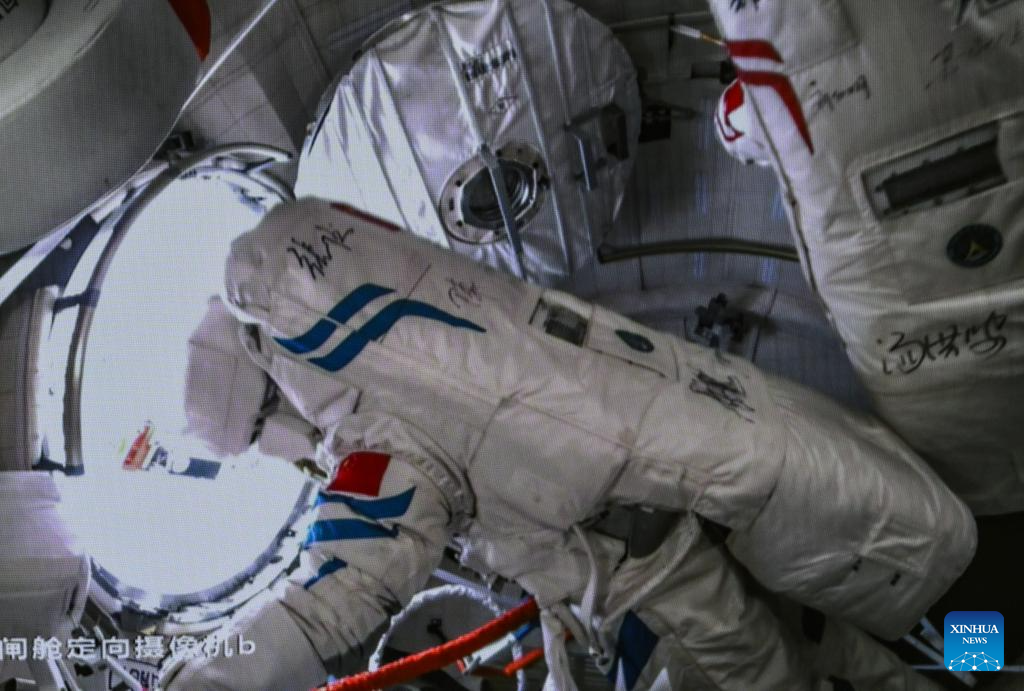
This screen image captured at Beijing Aerospace Control Center on March 2, 2024 shows Shenzhou-17 astronauts Tang Hongbo (R) and Jiang Xinlin (L) returning to the Wentian lab module. The Shenzhou-17 crew members, who are currently on board China's space station, have completed their second extravehicular mission on Saturday. (Xinhua/Li He)
Quelle: Xinhua
----
Update: 15.04.2024
.
Space Devices Ensure Health of Taikonauts Aboard Tiangong Space Station
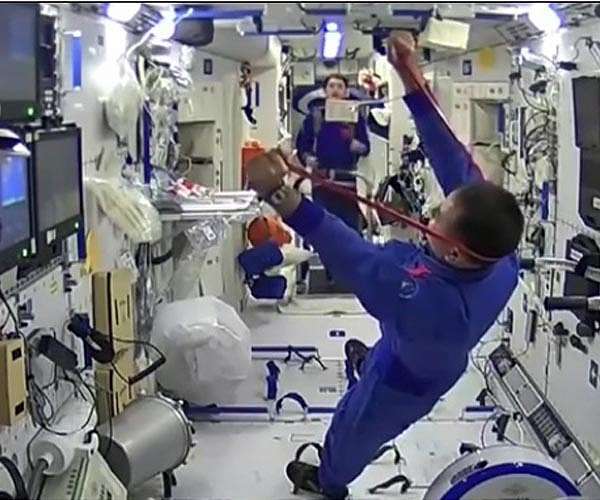
The China Manned Space Agency recently showcased new devices aboard the Tiangong Space Station, essential for maintaining the health and safety of taikonauts in zero gravity. These tools have become critical as China aims to extend the duration of manned missions.
The agency highlighted the routine of taikonauts engaging in extensive physical training to combat the effects of prolonged microgravity. These include muscle atrophy, irregular heart rhythms, and immune system issues. The space station, equipped with a variety of exercise equipment such as rowing machines, treadmills, and resistance apparatus, provides necessary facilities for daily workouts spanning one to two hours.
Furthermore, the crew utilizes uniforms integrated with elastic resistance bands, aiding in muscle tension and mitigating the impact of weightlessness. Medical teams on Earth monitor vital health metrics such as body temperature, blood pressure, and heart rate in real time, ensuring continuous health assessment.
Notably, the Shenzhou-11 mission in 2016 saw the inaugural use of a space-to-Earth telemedical consultation system, enabling real-time health data transmission and medical support from terrestrial doctors.
The onboard clinic enhances the station's capacity for health care, equipped with compact medical devices like cardiopulmonary resuscitators and ultrasound machines to conserve space. These tools support regular health monitoring and emergency medical responses.
Wearable tech allows for the continuous tracking of taikonauts' health data, which proves valuable even during communication blackouts, such as re-entry into Earth's atmosphere.
Additionally, the Tiangong Space Station offers traditional Chinese medicine treatments, a unique feature compared to its international counterparts. Recent footage from the Shenzhou-17 mission displayed taikonauts using TCM diagnostic tools, following the viral popularity of acupuncture sessions aboard Shenzhou-13 in zero gravity.
Quelle: SD
----
Update: 1.05.2024
.
China's Shenzhou-17 separates from space station combination, starts journey home
China's Shenzhou-17 manned spaceship separated from the country's space station combination at 8:43 a.m. Tuesday (Beijing Time), according to the China Manned Space Agency (CMSA).
Three astronauts aboard, Tang Hongbo, Tang Shengjie, and Jiang Xinlin, are returning to Earth after staying in orbit for about half a year.
The CMSA said that prior to the separation, the Shenzhou-17 crew, with the assistance of the ground staff, completed various tasks such as setting the status of the space station combination, processing and transmitting the experimental data, and transferring remaining supplies, and then carried out handover work with the Shenzhou-18 crew.
China launched the Shenzhou-18 manned spaceship on April 25, sending three astronauts -- Ye Guangfu, Li Cong, and Li Guangsu -- to its space station for another six-month mission.
Quelle: Xinhua
+++
China’s Shenzhou-17 crew return to Earth
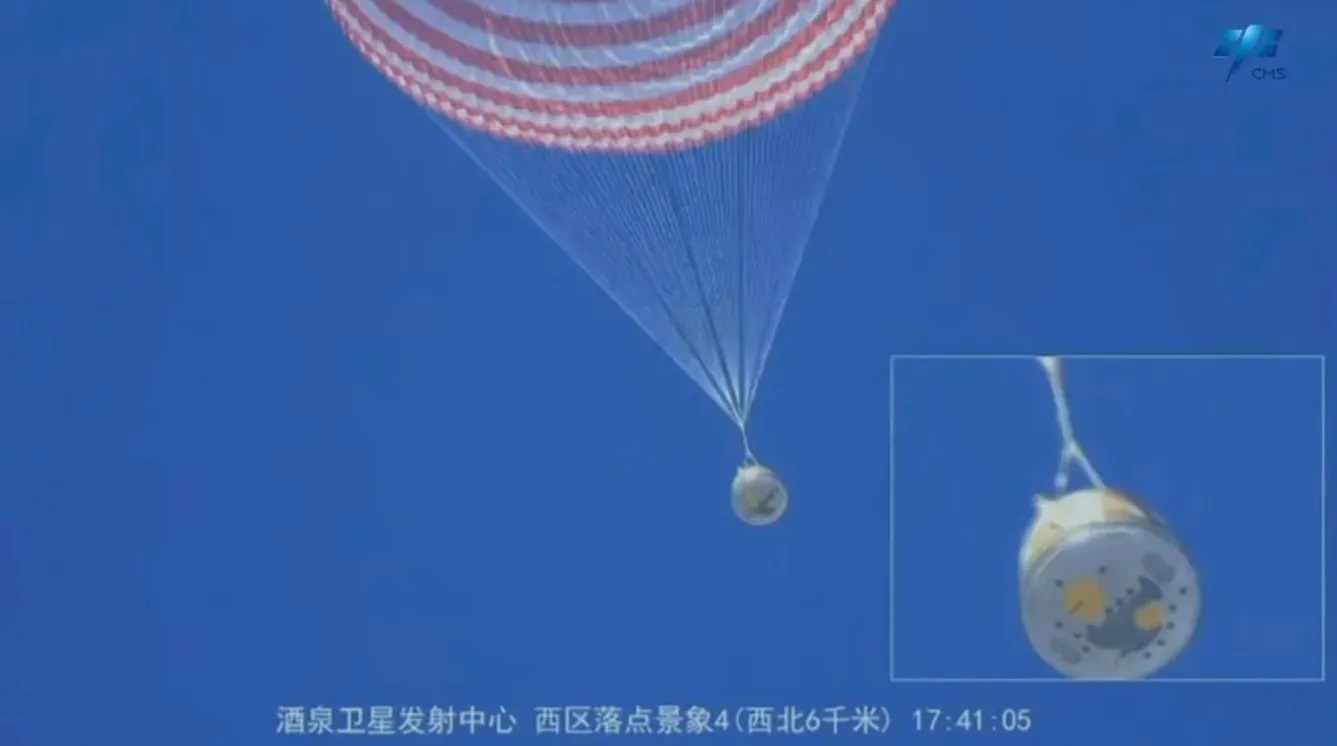
A view of the Shenzhou-17 reentry capsule as it descends to Earth, slowed by its main parachute. Credit: CMSEO
HELSINKI — China’s Shenzhou-17 crew returned to Earth Tuesday following six months aboard the Tiangong space station.
Astronauts Tang Hongbo, Tang Shengjie and Jiang Xinlin had been operating the Tiangong space station since October. The crew departed the station at 8:43 p.m. Eastern April 29 (0043 UTC on April 30) and landed at Dongfeng landing site in Inner Mongolia Autonomous Region near Jiuquan spaceport at 5:46 a.m. Eastern (0946 UTC) April 30.
Recovery crews were on the scene moments after the return capsule touched down. Commander Tang Hongbo was first out of the capsule. “I feel so proud for my country. I departed in autumn and came back in spring and I feel I have experienced the most beautiful seasons,” Tang said.
“Flying for over 180 days in the space station, I finished all the tasks, but at the same time, I miss my home everytime I fly over my homeland.”
Shenzhou-17 launched Oct. 25 Eastern, 2023, taking over control of Tiangong from the outgoing Shenzhou-16 crew days later. Tang Hongbo and his colleagues welcomed the incoming Shenzhou-18 crew aboard Tiangong April 25.
The two crews participated in a handover ceremony April 28. Tang handed over the hatch key as a symbolic handing of the baton to Shenzhou-18 mission commander Ye Guangfu.
The Shenzhou-17 crew embarked on two spacewalks to conduct repair and maintenance work on the station’s solar arrays. The panels had suffered damage from micrometeoroid strikes.
The trio also oversaw the arrival of the Tianzhou-7 cargo resupply mission in January. The astronauts also sent live lunar new year’s greetings to television viewers on Earth and participated in electroencephalogram (EEG) tests, which focused on the human brain in space.
They return having conducted 84 in-orbit experiments with more than 200 samples produced, according to China Central Television (CCTV), and have brought back over 400 material samples retrieved after being exposed to space outside the Wentian experiment module.
The Shenzhou-18 crew will carry out more than 90 experiments aboard Tiangong. They will conduct two to three extravehicular activities and six cargo outbound deliveries via the station’s cargo airlock during their six-month-long mission.
Shenzhou-17 was the sixth crew to visit Tiangong. While crewed missions and handovers have apparently become routine for China, the country is advancing its human spaceflight ambitions.
China is close to selecting a fourth batch of astronauts which will be trained to travel to, and work aboard, Tiangong. The new batch may also be involved in training for China’s crewed lunar plans.
China approved its space station plan in 1992 and began building the three-module, T-shaped low Earth orbit outpost in 2021.
China is preparing to expand Tiangong in the coming years. The first move will be sending a multi-functional expansion module with six docking ports to the orbital outpost. This expansion could allow for greater possibilities for international, tourist and commercial visits without disrupting core operations.
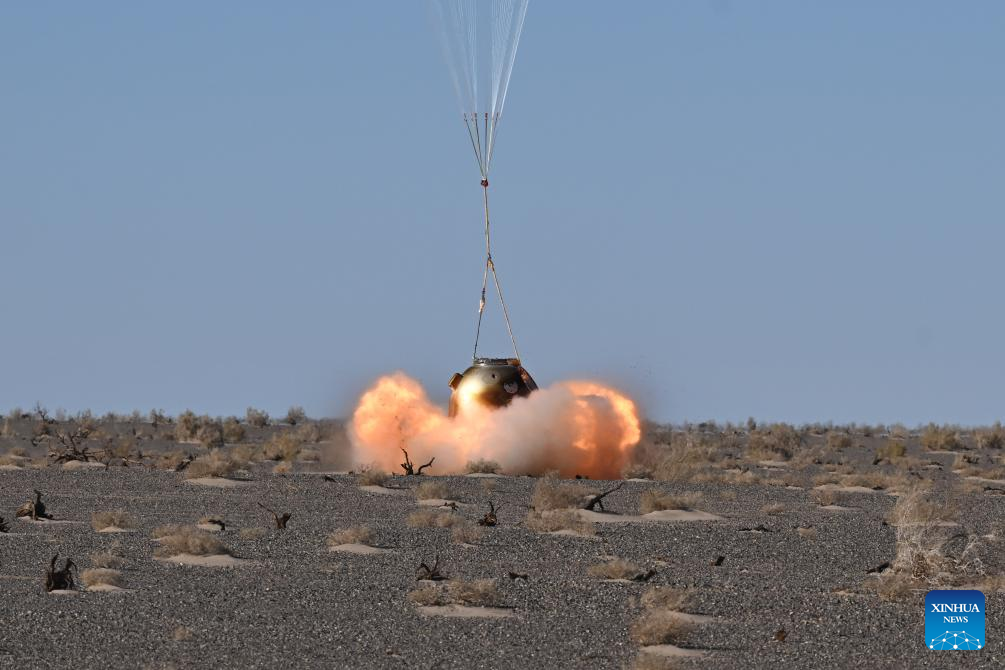
This combo photo taken on April 30, 2024 shows the return capsule of the Shenzhou-17 manned spaceship carrying astronauts Tang Hongbo, Tang Shengjie and Jiang Xinlin, touching down at the Dongfeng landing site in north China's Inner Mongolia Autonomous Region, April 30, 2024. The three astronauts are all in good health condition, according to the China Manned Space Agency. (Xinhua/Lian Zhen)
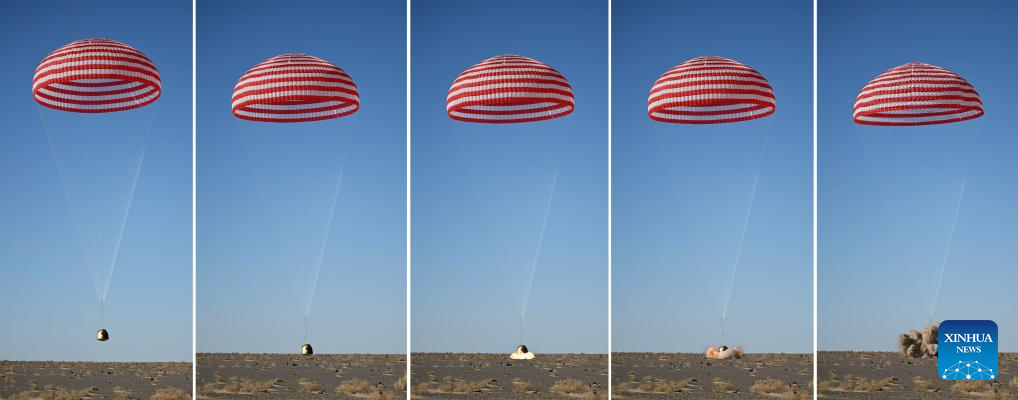
Quelle: SN
